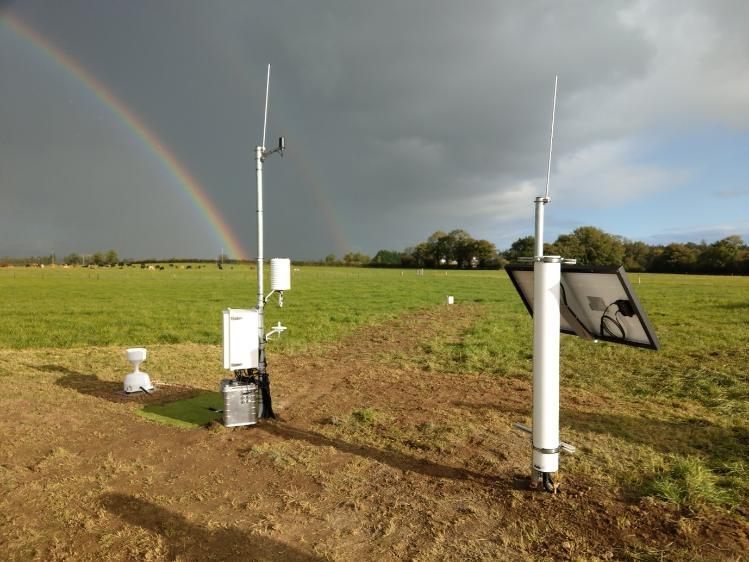Launch of Irish Soil Moisture Monitoring Network (ISMON)
A new Irish Soil Moisture mOnitoring Network (ISMON) is being established. The announcement was made by AGMET, the Joint Working Group on Applied Agricultural Meteorology. Funding has been provided by the Department of Agriculture, Food and the Marine (DAFM) under the national Carbon Tax Fund to establish a network of 10 sites equipped with state-of-the-art technology to monitor soil moisture conditions in real time and over the long term. These sites will cover the major soil types, land uses and climatic regimes in Ireland. This project is being jointly led by members of the UCD Earth Institute, Met Éireann and Teagasc.
Soil moisture (ie the amount of water in the soil) is a key driver of many soil processes influencing both agricultural and environmental outcomes. For example, plant growth (crop yield) is often strongly correlated with soil moisture conditions during both wet and dry periods and the risk of greenhouse gas emission or nutrient losses to water associated with fertiliser application is strongly influenced by soil moisture conditions. Soil moisture conditions will also strongly influence the processes of accumulation or loss of carbon in soils.

Soil Moisture Monitoring station at Irish Farmers Journal Tullamore Demonstration Farm, Co. Offaly, where ISMON was launched 5 October 2021. On the right the Cosmic Ray Neutron Sensor with solar panel, in the middle the data logger, air and grass thermometer, and relative humidity sensor, and on the left the rain gauge to measure precipitation. In the distance the junction box shows the location of soil moisture probes. Photo by Tamara Hochstrasser 5 October 2021
Paul Murphy, Assistant Professor in Soil Science, UCD and member of the UCD Earth Institute, said: “With climate change in Ireland expected to bring increasing variability and extremes it will be increasingly important to have an improved understanding and forecasting of soil moisture conditions specific to Irish soils and climate. Recent “fodder crises” have highlighted the vulnerability of Irish farming systems to some of these predicted climate changes. It is imperative, therefore, to improve our understanding of soil moisture dynamics to both mitigate and adapt to future climate change.”
Tamara Hochstrasser, Assistant Professor, UCD and member of the UCD Earth Institute, said: “Driving collaboration between universities, Teagasc, Met Éireann and DAFM made ISMON possible. The new data will allow us to understand ecosystems and farmlands in ways we could not to this day, and manage them more effectively through a changing climate."
The ISMON long-term observation platform will significantly enhance our understanding of the water cycle. Accurate information on soil moisture conditions from ISMON will further improve short and medium term weather prediction. Such monitoring and modelling, and associated advisories and decision support tools (DSTs) will become increasingly important for a wide range of real life applications, such as the protection of soil and water quality and mitigation of greenhouse gas emissions in farming and forestry and flood and fire forecasting and risk management.
The Director of Met Éireann Eoin Moran said “The measurement of actual soil moisture will also provide a vital validation data for prediction models of soil moisture and increase the reliability through ongoing verification. This will include the better prediction of severe weather and long-term climate change and its impact on environmental and water resources.” Eoin continued: “As we witness the growing effects of climate change it is vital to have an accurate assessment of soil moisture in a comprehensive and country wide manner, i.e. for numerical weather prediction, flood forecasting, drought assessment, water resource management and wildfire risk.”
Teagasc Director, Professor Frank O’Mara welcomed the establishment of the ISMON and said: “the improved measurement and prediction of soil moisture will enable farmers to further tailor farm advice, such as fertiliser and manure timing, to avoid conditions that lead to lower efficiency and contributes to environmental loss. Refined mapping of soil moisture will facilitate precision agriculture to adjust management practices, both in time and space, to improve efficiency and sustainability.”
There will be ten stations across Ireland where soil moisture conditions will be monitored using a network of soil moisture probe arrays and a state-of-the-art cosmic ray neutron sensor that can measure soil moisture conditions over a large area (approximately 0.6 hectares). The ISMON will place Ireland at the forefront of research and practice in monitoring and modelling soil moisture conditions and in the application of this information, internationally.
This new observation network will complement Met Éireann's existing weather station network, and other existing monitoring networks such as the Teagasc Agricultural Catchments Programme and newly established networks and sites such as the National Agricultural Soil Carbon Observatory (NASCO) network, the Terrain AI project, the UCD Long-term Grazing Platform at UCD Lyons Research Farm and the Irish Farmers Journal Tullamore Demonstration Farm. In many cases, instruments from these different networks and sites are being co-located to maximise the potential benefit from the range of soil, weather and other parameters being monitored.


